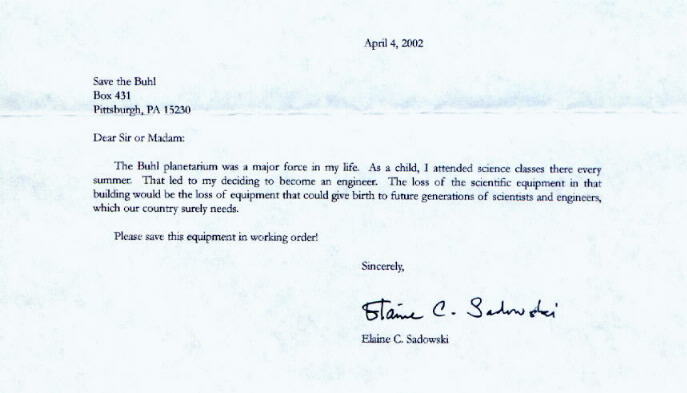

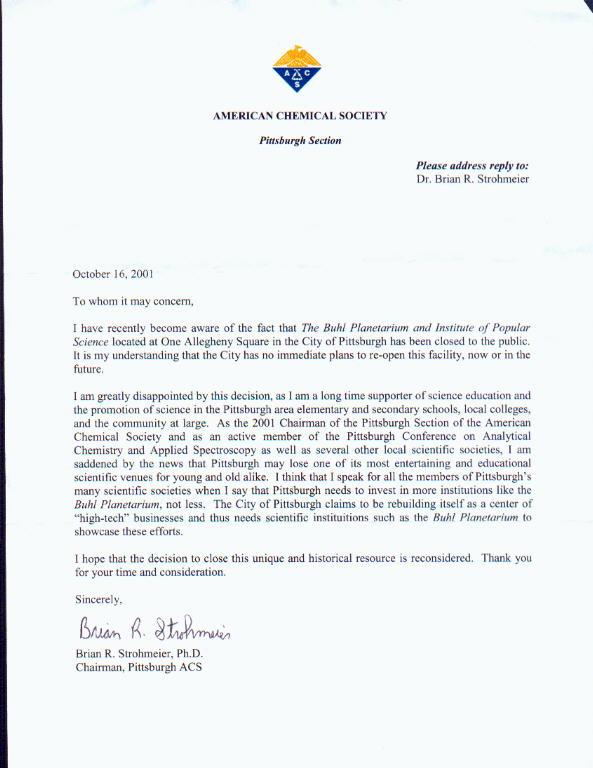
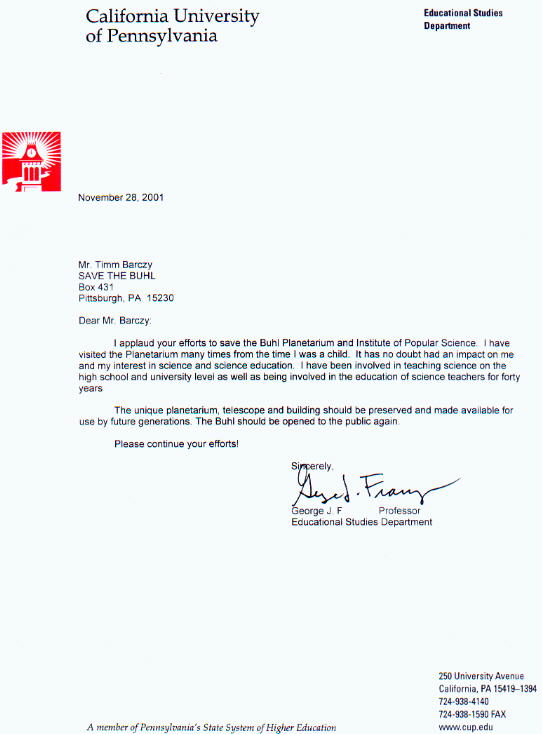
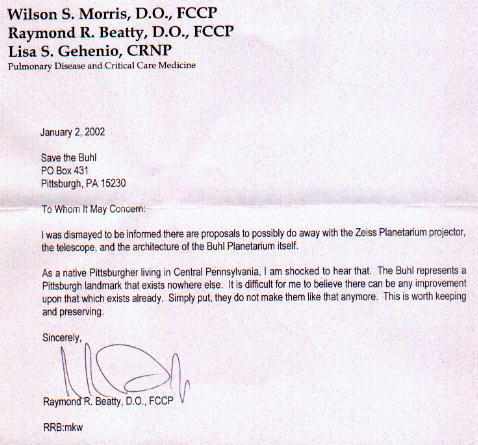
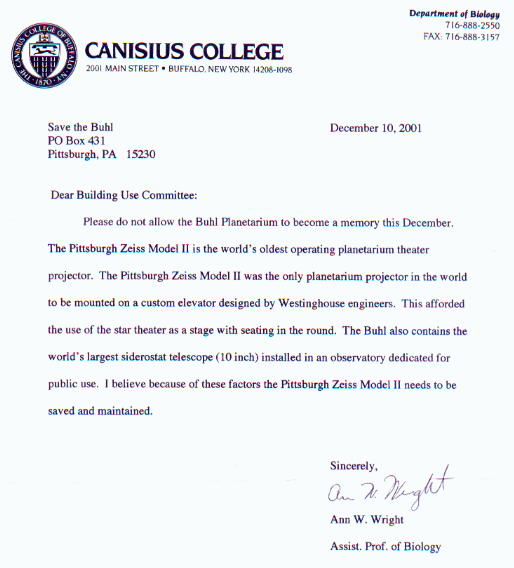






To whom it may concern,
It has been called to my attention that the Buhl Planetarium and Institute of Popular Science located at One Allegheny Square in the City of Pittsburgh is closed to the public, and the City has no plans to re-open this facility, now, or in the future,
I was greatly saddened by this news, for the grade school field trips to The Buhl Planetarium as a child are great memories for me, and is what began a lifelong interest in astronomy and other scientific studies. It troubles me to think that these experiences and important educational tools will be lost forever.
The Buhl Planetarium and Institute of Popular Science must be open to the public. This facility contains artifacts and equipment of regional and national historic significance. The Zeiss Model II star projector and its mounting configuration doesn’t exist anywhere else in the world. Due to the nature of the facility, I believe that the Buhl can continue as an institution of scientific discovery without competing with the city’s current science center. Please consider this letter a vote for keeping The Buhl Planetarium and Institute of Popular Science open to the public and a valuable component of Pittsburgh’s history and scientific heritage.
Thank you for your time and consideration.
Glenn P.
Allison Park, PA
From the November 16, 2001 issue of ROCKETMAIL
ANTIMUSEUMS
WHEN ONE THINKS OF A MUSEUM, one thinks of a place where curious things of the past or present are preserved, conserved, in the museum sense of the world. Thus dinosaur skeletons and old airplanes might come to mind. The work of historical preservation is ongoing, and the exhibits enlighten and explain the rare things brought to view.
Another type of thing is being labeled a museum. Suppose I create a space where learning activities occur, having little or anything to do with the conservation of rare curios. This might be a "science activities" center or some such thing, with an atmosphere resembling Chucky Cheese and sometimes even including a Pizza Parlor. They are fun for kids and adults. They, therefore bring in a steady income for the profit or nonprofit organization running it.
Now imagine if the space for this other thing conflicts with the space for the preservation-type of museum. Then the activities center, calling itself a museum, seeks to eliminate the preservation work and annihilate the past. This new type of entity, which labels itself a "museum", and often has approbation and status, is really destroying the past and opposite the task of a museum. It has become an ANTI- MUSEUM.
The Children's Museum in Pittsburgh, under Jane Werner, is such an Antimuseum. It seeks to acquire the Buhl Planetarium building and gut the planetarium projector and star theatre. It will not even consider an accommodation to the past. Its director's mindsets are yet another example of the kind of minds that would produce an Orwellian memory hole. The past is therefore annihilated. Lets have fun instead!
Author's name withheld on request East Pittsburgh, PA
To whom it may concern,
We would like to express our concern regarding the preservation and the perpetuity of Buhl Planetarium. It isn’t necessary to replace everything in life and community, especially something so unique. I am not well versed to argue the pro’s and the con’s. I only know what I like, and fine endearing, even a piece of machinery. Please give this issue considerable thought. Thank you for taking the time to read this letter.
Mr. and Mrs. Emory J. B. Sr.
North Huntingdon, PA
To whom it may concern,
It is my understanding that the Buhl Planetarium and Institute of Popular Science located at One Allegheny Square in the City of Pittsburgh has been closed to the public and that the City has no immediate plans to re-open the facility.
The Buhl Planetarium holds a number of great memories for me personally. I frankly love to go there as a child and I would still as an adult! Now that I see the growing lack of interest for science in our youth, I can't help but wonder why. Is our society blindly worshipping sport teams and their $250,000,000 fields that we just don't see the beauty of the natural world around us? Are children asking, "How does that work?" more now or fifty years ago?
I'm on the faculty at Carnegie Mellon and most science departments across the United States find it increasingly difficult to recruit domestic science students for graduate school. Places like Buhl impacted me and gave me the exposure to science which directed me even more so into the field. At age five I saw the Zeiss star projector rising from the floor at the start of the sky show and it was frankly, wonderful! It bothers me to think that this sight will not be shared with our youth in the area and that viewing this and the other displays no longer adds to the intrigue of our children.
The Buhl Planetarium and Institute of Popular Science must be open to the public. The Buhl Planetarium's unique architecture and contents are or regional and national historical significance. The facility contains artifacts and equipment that are unequaled anywhere else in the world. The Zeiss Model II star projector and its mounting exist nowhere else, but here in Pittsburgh. We need to preserve the historical and scientific equipment and the history of the Institute for future generations. Due to the unique nature of the facility, I believe that the Buhl can continue as an institution of scientific discovery or scientific museum without directly competing with the city's current science center of scientific museum. (Columbus Ohio, Hutchinson Kansas, and London England successfully host more than one public science facility.)
Please consider this letter as a vote for keeping The Buhl Planetarium and Institute of Popular Science open to the public and a valuable component of Pittsburgh's historical and scientific heritage.
Thank you for your time and consideration.
Very truly yours,
Mark E. B. Ph.D. Pittsburgh, PA
To whom it may concern:
I have recently heard that there is an effort to re-open the old Buhl Planetarium to the public. What a wonderful idea!!! I grew up in Pittsburgh in the 70's and 80's and have pleasant memories of visiting the planetarium for seasonal sky shows, the Christmas train displays, meetings of the Amateur Astronomy Association of Pittsburgh and even Lasarium shows. I now live in Austin, Texas, a city that does not have a planetarium or science center. The importance of preserving the educational and cultural legacy of a city becomes clear when you live in a town that lacks these types of public resources.
Buhl's influence was far greater than its science education contribution. I was always captivated by the classic architecture of the building, the unique artwork depicting the industrial legacy of Pittsburgh, and the simple, yet informative and aesthetically pleasing displays like the Foucault pendulum, the spider-like planetarium projector and the giant globe. You couldn't help to realize that the place was special. I admit being saddened when I learned that a new science center was being built and that Buhl was going to close. The new science center is interesting and informative, but lacks Buhl's cathedral-like quality that awed and inspired. It surely impacted countless people, not just those with a deep appreciation of science.
The significance of the planetarium and its classic and timeless instruments is profound to many people. The preservation of Buhl will provide a window to the past to children growing up in the age of technology, plus will preserve a piece of Pittsburgh's contribution to the public appreciation of science. It was and can be again an important and unique part of the city. I fully encourage the effort to re-open Buhl - it is a gem too precious to lose.
Sincerely,
Pete W.
Round Rock, Texas.
Dear Sir,
I've noticed for a few years that the Buhl Planetarium on the North Side is closed, at the Allegheny Square site. The Old Planetarium has been a source of great tradition and memories for me for many years. Walking in front of the grand old building on Saturdays and Sundays, I've been stopped by many people asking me when the Buhl will open. I said so far as I know, it's permanently closed.
People related family stories to me, especially the Miniature Railroad and the Christmas Tree in the Buhl Planetarium and the "Light Shows" that were shown there. I understand that the Buhl is one of the last Planetariums to stand in the United States, with its graceful blue/green dome. The Zeiss is a great piece of astronomy history. This facility should be saved as a "one-of-a-kind" PLANETARIUM!
Please keep the "Old" Buhl as a GRAND piece of Pittsburgh's history and a VALUABLE PIECE OF PITTSBURGH'S DEVELOPMENT AS A MAJOR U.S. CITY.
Thanks for listening to me.
Stephen P.
Pittsburgh, PA
SHOULD WE REALLY EXPECT THINGS TO CHANGE?
It has been said that if it looks like a rose, and smells like a rose, there is a high probability that said flower is a rose. This same axiom can be equally applied to eminent domain in the Original Buhl Planetarium, City of Pittsburgh, Carnegie Science Center, Children’s Museum, scenario. Permit me to elucidate. A second party may approach a property owner with an offer of intent to purchase property for a slightly less than reasonable price as a fact-finding tactic to assess the owner's willingnes to sell. When the owner is unwilling to negotiate a sale to the second party, eminent domain may be used as a tool to acquire the property.
Eminent domain usually involves the condemning of private property by an agent of a governing body. After condemnation proceedings have concluded, the property is publicly declared, usually as an announcement in the local print media, to be unsuitable for use. This action radically lowers the fair- market value of said property and forces the owner to relinquish the property on the "open market" at a less than optimum price. The property is then purchased by a second party for a percentage of the actual value. The new owners are touted by the media as being heroes for rescuing this tainted property and putting it to productive use. Little coverage is generally given to the original owner who made successful and productive use of the property up to the point of its "condemning".
Here is the parallel. The City of Pittsburgh owns the contents and the building known as Buhl Planetarium and Institute of Popular Science in Allegheny Square. It seems unlikely that the City would condemn a building it owns. However, there seems to be little problem regarding the status of the contents. The Zeiss and the Siderostat Telescope, contained within Buhl, have been "condemned" for public use by the Director of a local planetarium. (The fact that this equipment has operated for over 50 years seems of little importance in this agenda.) Since these two items are owned by the City of Pittsburgh and this individual is providing "expert" testimony regarding the status and deposition of said property, he is operating as an agent of said government. (Perhaps the City would be willing to provide the public with the criteria and screening process used to select this incontrovertible source for expert testimony in these proceedings.)
Let us not forget that this Planetarium Director also represents the interests of the local science center as well. The operation of this equipment at its present site (the Buhl at Allegheny Square) may be construed as a duplication of services and represent a potential threat of competition to their present venue. Declaration of this equipment as inoperable would assure the elimination of the possible threat of competition. (Remember the good old days when competition was a good thing!) The removal of the equipment would permanently eliminate the potential competition. (The fact that the technologies used to produce sky-shows at each location are radically different which precludes the possibility of competition, seems to be of little consequence.) The Director of the planetarium alluded to me that the local children’s museum would have no further interest in the building if the assets are to remain. (A rather inflexible bit of posturing.)
Let’s pause to look at the big picture. The Director of the local children’s museum has made it abundantly clear that their agenda does not involve the retention or use of this equipment. The local children’s museum is posturing with the notion that the building is of no use to them if this equipment is to remain. This implies that the only way for them to rescue this "old and neglected" structure is to remove the equipment. It also appears that this circular logic has convinced city government that this is the best and only option for the building and its contents. The Director of the local planetarium, perhaps by coincidence, convenience, or collusion, just happens to think that this equipment would best serve the public if it were mounted into the science center as dysfunctional knick-knacks.
So what’s the outcome? The building is rescued, albeit radically altered to erase its former identity, while unique and priceless scientific instruments become little more than static mirth. The children’s museum and the science center are portrayed as hero’s by the media for their incredible "rescue" efforts, and the city is "proud and pleased" that their building has found a new life. This scenario has been propagated by the media as being the best and only possible option to implement.
Perhaps the media, and other vested interests are terrified in regards to the possibility of considering other viable options. It’s tragic that the media choose to portray those (scientists, engineers, technicians, intellectuals, concerned people of the region, and tax-payers all) who support an alternative plan, as "protesters" (individuals who provided 3-minutes, each, of testimony at public meetings) and "nostalgic nay-sayers" (those who value the region’s history). This form of denigration is a discredit to all who choose to actively participate in the democratic process.
Perhaps the media-at-large would do itself, and the public-at-large justice by applying the rules of objective journalism. This short, but less-traveled road would lead the media to "discover" that those who have been denigrated are the futurists and visionaries involved in landscaping the scientific and technological terrain of our region.
Yes Virginia, there is a scientific community in Pittsburgh! The fact that this community would have an opinion regarding the fate or possible future of Buhl Planetarium should come as no surprise. The fact that the process has occurred without their invitation, participation, or input can only be described as repugnant.
Science has the task of searching for objective truth. It is my hope that government has equal
regard for objective truth and demands that it be sought and incorporated in the process of government
decision-making. It also my hope that the media has equal regard for honesty, for I personally can think of
no virtuous incentive for the omission of truth.
Timm B.
Pittsburgh, PA
Pittsburgh, PA 15204
April 4, 2002
SAVE THE BUHL
PO Box 431
Pittsburgh, PA 15230
Dear Friends of Buhl,
I was a student at the Buhl Planetarium, and started about the time Sputnik went up (when I was 7 years old). I spent my Saturdays with the Buhl Junior Space Academy for the next 5 years (and was Top Student for three years in a row). I continued to take courses at Buhl until just before I reached high school (and then went on to get an electrical engineering degree from CMU). I was able to enter CMU as a Freshman at the end of my Junior high school year, partly because of the training, experience and encouragement I obtained at Buhl Planetarium.
I have many fond memories of the Buhl. I never went to the new place, having been to one like it in New Jersey (right across the harbor from lower Manhattan). I wasn't impressed. To much show and too little know.
Buhl Planetarium: I remember it all - the blacklight in the Hall of the Universe (well before the '60s made it popular) and the neat exhibits in that strange environment, killing time waiting for the Foucault Pendulum knock down a peg, trying to watch the Tesla Coil without holding my ears, and all the neat gizmos they sold in the gift shop (like the Radiometers). Bought my DynaScope 4 inch reflecting telescope there, after coveting one for years (saved up my pennies).
The van de Graff generator was also a hit, especially when the lecturer touched it and his hair stood up. I loved the Lecture Hall with its red upholstered seats and deco lighting fixtures. I'll never forget the seminar there where the instructor put a tennis ball into liquid nitrogen and then throw it against the wall - where it shattered like it was made of glass!
Saw sunspots projected through the Siderostat Telescope upstairs many times. Even was there once or twice at night when it was clear with a few of the staff I knew, rifling through my well-worn Olcott and Mayall "Field Book of the Skies", which I bought downstairs, trying to see if any interesting double stars or deep sky objects were within view.
Since I knew a few of the staff members I got to see most of the behind-the-scenes things over the years - like the Zeiss projector elevator and the exhibit preparation workshops downstairs. Some of those ancient exhibits would have major historical popularity today - like the relay-based tic-tac-toe game or the "record your voice" display with the oscilloscope. Even their take on the carney "ring-the-bell-with-the-hammer" game - the generate-your-own-electricity bicycle complete with higher-brightness bulbs that lit up with faster pedaling. Great stuff - today places like the Science Center are far too Disney.
This may seem strange, but one of the most unique things about the place was the way it smelled. It was hard to describe, but it was sort of a cross between a library and, say, a museum with antique tapestries. Maybe it was all of that ozone in the air from the giant Tesla Coil. I found it very comforting and relaxing.
When I took the trolley to my Saturday classes I'd always have lunch at the North Side Market House. There were a number of counters there that were excellent. The one I always went to had a counterman who knew me by name and would always give me my coke for free.
I stopped going to the Buhl about the time they destroyed the North Side.
It's shocking how little disregard people have for history. I know this first hand because I know a bit about historic preservation. Professionally I'm a private engineering consultant in the passenger rail transportation field, but on my own time I'm a volunteer worker, Trustee, and President at the Pennsylvania Trolley Museum near Washington, PA. PTM got its start back in the 1950s doing many of the same things you guys are trying to do now. The story on your Web site about the items in the dumpsters and the scattering of the library is tragic, and struck a nerve. It's similar to what PTM's founders did back in the 1950s and 60s to preserve material, and what many of us did over the years on our own.
Please note that I'm not speaking for or representing in any way the Pennsylvania Trolley Museum, but am writing this solely as a private citizen who wants to do everything he can to help save some extremely valuable and useful historical artifacts.
The Zeiss II projector is not merely historical, it's a precision scientific instrument that runs better than the legendary Swiss watch. I did some work at Spitz Space Systems in Chadd's Ford PA (they were contract-building some electro-mechanical devices for a client of mine there years ago) and many of the people there, who made new planetarium projectors, held the Zeiss pre-war projectors (of which ours is the only survivor) in awe. The Zeiss remains as useful today as it did when it was built. And the Siderostat Telescope is one of the largest of its kind anywhere, and extremely useful as an instructional tool for children.
I am appalled at the apparent lack of concern voiced by the Children's Museum over the true nature of these instruments. And their usefulness - these instruments were MADE to educate children! The telescope in particular has immense educational value - why do they want to remove it? One would assume that the Children's Museum is interested in educating children and giving them a true educational experience - not merely entertaining them in Kennywood fashion. The telescope could become part of a true educational program - and it's there already, waiting. To a child, seeing the rings of Saturn or the craters of the Moon through a telescope is every bit as fascinating as dinosaurs could ever be!
All they need do with the projector is agree to leave it alone in the basement. Why are they objecting to this? This is crazy and defies logic. They can use the theatre above for their planned uses, why does the projector have to go? They know as well as we all do that to remove the projector is to destroy it, and they don't care - because it's "inconvenient" for it to remain.
What hogwash! If it wasn't for the historical preservation movement that saved the old North Side Post Office building that they now occupy, the Children's Museum wouldn't even exist! The original Allegheny Center plans called for it's destruction.
Why is the Children's Museum so blind to the incredible opportunities here?
Keep up the good work!
Gregory J. W.
 Back To Lobby
Back To Lobby
© 2001, 2002, 2003, 2004 SaveTheBuhl.org